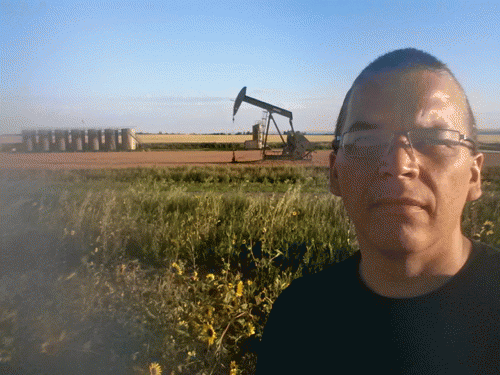(Article changed on September 2, 2013 at 21:37)
(Article changed on September 1, 2013 at 20:25)
Prairie sunflowers swayed in the late afternoon August light while Lunker Federal #2-33-4H clanked and moaned as she pumped fracked Bakken crude for the Slawson Exploration Company. Somewhere, hidden on the golden shoreline, Piping Plovers protected by the Endangered Species Act of 1973 were raising their young. The blue waters of Lake Sakakawea shimmered like a mirage in the low humidity of the hot summer afternoon and formed the perfect backdrop for a cautionary tale about fracking for crude on the Fort Berthold Indian Reservation in western North Dakota. It is a story about communication between state and federal agencies and treaty obligations that are sometimes met, and occasionally ignored. In this case, it is not so much about what is happening underground, but what is overlooked on the surface. The story is about development colliding with sacred traditions, the power of greed, and the future of a people. The ending is not written yet, but the arc of the story is ominous in its beginning.
Fracking is the method by which vertical and horizontal drilling into the earth's surface at depths of a mile and more, combined with the injection of water and chemicals, creates channels in rock and shale which release gas and oil. A well is considered to be producing when it is successfully pumping oil to the surface. The gas can be captured or burned off in a process known as flaring.
Fracking is extremely controversial and criticism can be environmental; ranging from ground water contamination, the danger of blowouts, and the destruction of fresh water sources. Spiritual considerations involve indigenous religious beliefs that tribes have a covenant with the Creator to protect Mother Earth from the insult of drilling into her surface.
"To frack or not to frack" is not germane to this discussion. It is already happening and there is no real possibility it will end anytime soon. The challenge to Fort Berthold, the people of the affiliated tribes living there, the tribal government, and federal agencies assigned to "caretaker" roles is one of responsible management, transparency, and communication.
As of August 15 the number of rigs drilling on the Fort Berthold Reservation is up to 22 with 6 on fee lands and 16 on trust lands. There are now 979 active wells; 111 on trust lands and 868 on fee lands. The active wells are producing 256,726 barrels of oil per day; 88,330 from trust lands and 148,895 from fee lands. 148 wells are not yet complete.
There are 262 approved drilling permits; 252 on trust lands and 20 on fee lands.

Frank Jr. Molley of Honor the Earth at Lunker Federal #2-33-4H
(Image by Frank Jr. Molley) Details DMCA
On December 12, 2012, an oil and natural gas "event" produced a 40-50 foot geyser of Bakken crude oil mixed with salt water. The Slawson Exploration company, according to a complaint (Case No. 20012) filed by the North Dakota Industrial Commission (NDIC), was performing a clean out operation on the well by removing hydraulic fracturing material in order to restore the well to a productive status. Pressure control equipment failed and caused a blowout triggered by a catastrophic release of subsurface pressure. Water, oil and gas continued to flow until two days later when a replacement blowout preventer was installed on the wellhead. The complaint was an administrative action requesting relief from Slawson for "violations of sections of the North Dakota Administrative Code (NDAC) governing the oil and gas industry."
In an April response, Slawson contested every last count leveled against them in the March complaint. Attorneys for Slawson included Count 6 in their argument for dismissal, and Count 6 was a statement of fact that the blowout occurred.
So the blowout never happened? Take a look at the video of the "event."
The initial incident report (File 23105) from NDIC said 800 barrels of oil and 400 barrels of fracking brine were released in the blowout. A subsequent February 14, 2013 progress report on the cleanup, prepared for Slawson by the environmental engineering firm, Lowham Walsh LLC, put the number at 1500 barrels. One barrel equals 42 US gallons, so think about what 63,000 gallons might look like. A recent local print newspaper report (BHG News) revised that number upward to 66,000 gallons, but it was unattributed. For a visual, think about what 1300 bathtubs or one swimming pool, 20 feet wide, 44 feet long and 10 feet deep looks like. Now imagine that amount of brine and oil sprayed into the air.
(Note: You can view every article as one long page if you sign up as an Advocate Member, or higher).





